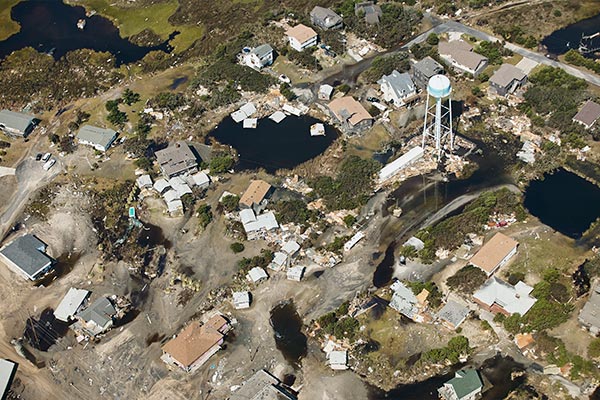Climate costs will mount across North Carolina's economy
Climate change is already impacting North Carolinians. Summers are hotter and longer. Flooding is more common and pervasive. Strong storms are becoming more frequent and severe. The damaging effects of these hazards are mounting, and without climate action, the people and economy of North Carolina will pay even greater costs.
This report by RTI International, commissioned by Environmental Defense Fund, showcases the projected costs of climate hazards across eight key sectors of North Carolina’s economy over the next 20 to 30 years.
Key impacts
Without action on climate change, North Carolinians could experience a range of rising impacts and costs.
Human health and safety
In the near-term, the most serious temperature-related impacts are likely to be those associated with extreme heat. For example, in the Raleigh, Wilmington, and Fayetteville areas, emergency room visits due to heat stroke and other hyperthermia conditions, characterized by abnormally high body temperature, are projected to increase two to threefold from 2010 to 2050. In many cases, these costs and impacts will be disproportionately felt by low-income and socially disadvantaged populations who have fewer resources and options for protecting themselves.
Agriculture and forestry
The most harmful impacts are likely to result from intensifying extreme events, such as hurricanes, extreme heat, droughts and floods. For example, Hurricane Florence in 2018 caused $1 billion in combined crop and livestock losses and $50 million in forestry losses. As the number of days with extreme heat rises in the coming decades, workers in the agriculture and forestry sectors will be particularly affected.

Hurricane Isabel first began affecting North Carolina about 15 hours before it struck land. Upon making landfall along the Outer Banks, the hurricane produced strong waves of 15 to 25 feet in height and a storm surge of about 6 to 8 feet.
Residential and commercial property
As climate change worsens, properties will face growing risks, particularly from sea level rise, hurricanes, floods, landslides and wildfires. More than 1,300 residential and commercial properties along the state’s coast, valued at almost $340 million, are at risk of chronic flooding. By 2045, with no climate action, this estimate increases to almost 15,600 properties, valued at almost $4 billion. Importantly, this growing threat will increase insurance rates and decrease property values, eroding the local tax base needed for community services, like schools and hospitals.
Commercial fishing and aquaculture
Commercial fishing, which has long been an integral part of North Carolina’s coastal culture and economy, and aquaculture are both likely to be impacted by more severe hurricanes and storms. For example, in 2018, Hurricane Florence caused $13.5 million in commercial fishing and aquaculture losses. In addition, changing ocean temperatures are expected to shift habitats for commercially caught fish species.
Energy supply and demand
More severe hurricanes and storms are likely to result in larger damages to energy infrastructure. For energy consumers, hotter and longer summers will drive higher demands for electricity. Growing energy bills under these conditions will be especially burdensome for low-income households across the state, and reliability may also become a major concern.
Transportation infrastructure
North Carolina currently spends roughly $1 billion per year to maintain the state-owned road network, and it is ranked 9th in the nation for average maintenance spending per lane-mile. Climate change, particularly through its effects on sea levels and extreme events, such as floods, extreme heat, and landslides, will make it increasingly costly to maintain this system.
Water infrastructure and services
The impacts of climate change are putting significant pressure on water systems and services, such as putting residents at higher risk of dam failures, and these pressures will only increase in the coming decades.
Recreation and tourism
From higher temperatures that are limiting skiing in the Appalachian Mountains to sea level rise that is impacting beach visits along the coast, popular outdoor recreation activities in the state are under threat. The range and size of these impacts on both residents and out-of-state visitors and the businesses that support them are likely to grow in the future.
Actions North Carolina can take now
North Carolina can still take meaningful action to help address the climate crisis and build resilience — all while capturing the opportunities and jobs that come with a clean energy economy. While federal action to climate change is crucial, this report outlines several meaningful actions the state can take.
These policy recommendations include:
- Implement a declining, enforceable limit on greenhouse gas pollution, paired with a price on state emissions.
- Spur the adoption of electric vehicles.
- Incentivize electrification and efficiency investments.
- Incorporate nature-based shoreline protections.
- Incentivize resilient farming practices that have multiple benefits, and much more.










